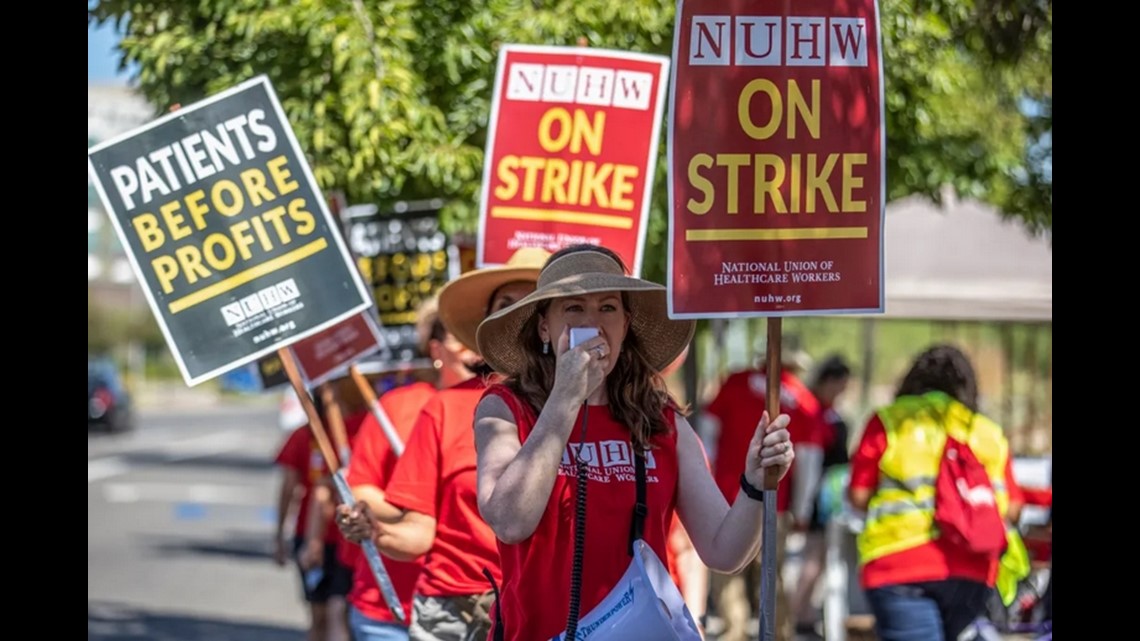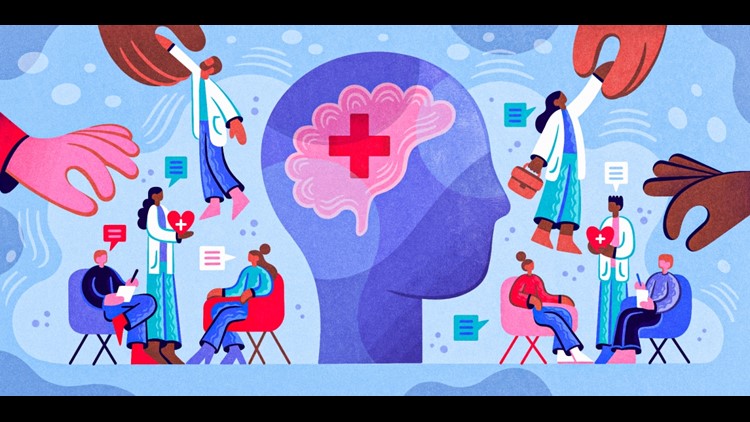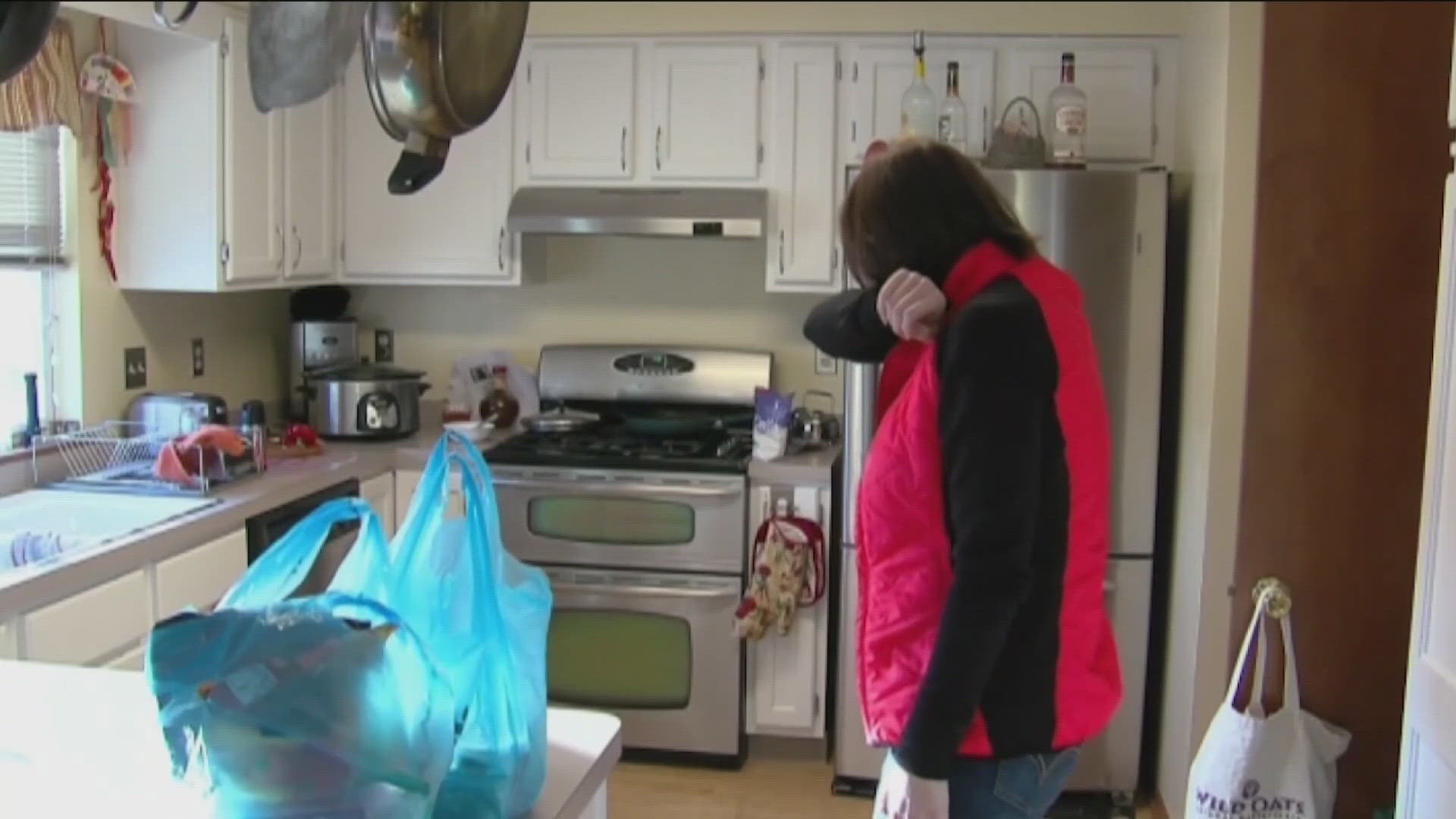SAN DIEGO — This investigation was first published by CalMatters.
The need for therapists, social workers, psychologists and psychiatrists is greater than ever. Under relentless pressure from the pandemic and inflation, wildfires and gun violence, racism and war, Californians are crying out for help.
But that doesn’t mean they can get it.
In every corner of mental health right now, a similar story is being told. There simply aren’t enough providers.
Patients receive lists of names from their insurers, only to learn none of the therapists on these so-called “ghost lists” will see them. Clinicians who do offer a spot often only accept cash.
Nonprofit mental health providers report needing to have an offer letter ready at a job interview, fearing applicants will take another position if they wait.
Kaiser mental health clinicians have been out on strike for weeks now in Northern California, describing exhausting working conditions and long delays in care for their patients. Kaiser, for its part, points a finger at a familiar culprit: the mental health provider shortage.
CalMatters spoke with more than two dozen mental health experts, public officials and providers around California to ask about the impacts of the mental health provider shortage, and what can be done about it. Their responses ranged from desperate to hopeful.
All agree we are at a pivotal movement.
In part, that’s because Gov. Gavin Newsom’s administration is investing heavily in overhauling the state’s mental health system. At the same time, the state has recently enacted laws requiring insurers to provide timely access to mental health care. Some worry a lack of providers could jeopardize these bold new initiatives. Others see this as an opportunity to reimagine how mental health care in the state is delivered.
Here’s what the experts had to say:
1. How big is the provider shortage problem?
It depends on what part of the elephant you’re looking at, said Catherine Teare, associate director of the California Health Care Foundation’s People-Centered Care team. County mental health departments are struggling to hire. So are commercial health plans. So are nonprofits.
At the same time, she said, “the level of mental distress is increased.”
“For children or adults who need a lot, or need it urgently, it’s a scary time.”
Dr. Mark Ghaly, secretary of the California Health and Human Services Agency, told CalMatters that the number of licensed behavioral health providers in the state increased by 20% between 2016 and 2020. But, that’s been offset by an increase in demand he calls “really unprecedented.”
For patients, how bad the shortage is depends, in part, on where you live, your insurance, your income, your age, the care you need and whether you want a clinician of color or one who speaks a language other than English.
A report published by the University of California, San Francisco, in 2018 – even before the pandemic sent need skyrocketing – predicted that by 2028, demand for psychologists and other therapists would be 40% more than supply. For kids, the shortage is especially dire. Close to a third of California’s 58 counties have no child and adolescent psychiatrists at all, according to the American Academy of Child & Adolescent Psychiatry.
A new report from the California Health Care Foundation shows that the Bay Area has 19 licensed psychiatrists and 73 licensed psychologists per 100,000 people – significantly more than the state averages of 12 and 44. At the other end of the spectrum, the San Joaquin Valley has six psychiatrists and 16 psychologists for the equivalent number of people.
Jessica Dominguez, a licensed marriage and family therapist at Kaiser Richmond who is currently on strike, said the Bay Area has plenty of providers.
“Throw a rock, you’re going to hit a therapist,” said Dominguez, who said she plans to leave the organization.
But others who work in the region, including Matthew Madaus, executive director of the Behavioral Health Collaborative of Alameda County, said “100% absolutely” there’s a shortage even in the Bay Area.
If you search for a behavioral health clinician on Indeed.com, he said, it comes up with thousands of open positions within a 25-mile radius.
“It’s extraordinary the level of demand,” he said.
One problem: It’s difficult to capture how many clinicians don’t accept any insurance at all, and thus aren’t accessible to the vast majority of patients who can’t pay cash.
What we do know: We need more and better data. For instance, some experts say the increase described by Ghaly does not reflect how many licensed providers are actually seeing patients, nor does it capture how many are seeing people who are uninsured or on Medi-Cal.
Democratic Sen. Scott Wiener of San Francisco authored a bill this year that would require the Department of Health Care Access and Information to prepare a report for the Legislature by Jan. 1, 2024, describing the state of California’s behavioral health workforce, and how best to address the shortage. Senate Bill 964 is on the governor’s desk.
San Diego County has already researched the shortage. Officials there estimate they currently have 17,000 behavioral health workers and need an additional 8,100 to meet current demand. In the next five years, they anticipate needing another 10,000 workers, in part because so many will be retiring.
2. What’s causing the shortage?
Mental health leaders will tell you the shortage itself is nothing new. But the pandemic has aggravated the problems. More providers have left their jobs, citing burnout. Or they’ve left the state, citing cost of living. New telehealth startups specializing in mental health treatment offer good pay and flexible hours; many experts said they have added to the demand by siphoning off providers from the public sector.
In a 2018 report on the behavioral health workforce shortage, Janet Coffman of UCSF also raised the concern that 45% of psychiatrists and 37% of psychologists would likely be retiring within a decade. The pandemic has accelerated this trend, she said.
Many clinicians say they’re simply exhausted. It’s not just that more people need help, but many of them are coming in sicker, with mental health issues that have gone untreated.
“Our patient population has become so much more difficult to work with than it used to be a decade ago,” said Randall Hagar, legislative advocate and policy consultant for the Psychiatric Physicians Alliance of California.
As openings go unfilled, those who remain are left to carry more of the weight, he said.


Another problem Hagar and others mention: paperwork. Doctors spend some 40% of their time on paperwork, he said.
Many clinicians, especially providers of color, also say they are simply not getting enough emotional support from their employers. Dominguez, the Kaiser therapist, said she founded La Clinica, a nationally recognized pilot program to serve Spanish-speaking clients, in 2016. When tragedies happen in the community, she said, they impact clinicians, too. But, “you’re just expected to plug along and keep going,” she said.
Continually witnessing trauma can be exhausting, said Jeff Capps, a social worker with Pacific Clinics in Los Angeles. He emphasizes the need to make the work more sustainable for clinicians. That includes better pay.
“Sometimes in our field, the assumption is that since you get value out of your work, you don’t need to be as compensated,” he said.
A 2019 report by the healthcare consulting firm Milliman found that commercial plans in California, when setting rates, pay primary care providers an average 15% more than they pay behavioral health providers.
Luke Bergmann, San Diego County’s director of behavioral health, said his county’s report on the provider shortage showed that, in some cases, people chose to work at Panda Express instead of substance use disorder clinics “because they simply cannot make as much.”
“People talk about loving the work,” he said. “For people to leave this work is an incredible emotional sacrifice.”
Candy Curiel, clinical director of Pacific Clinics for the Inland Empire, said inflation is making the situation even worse.
“Everything is so costly at this point, people feel they need to seek more money,” she said.
3. Everyone is competing with everyone else. Is this a zero sum game?
Michelle Cabrera, executive director of the County Behavioral Health Directors Association, said the state’s mental health system is so overwhelmed, everyone is poaching from each other.
“Let me be clear: It is a zero-sum game,” she said. “There’s only so many licensed or competent professionals in the state of California to do these jobs.”
In August, state Superintendent of Public Instruction Tony Thurmond announced that he had secured funding to hire 10,000 additional mental health clinicians to serve the state’s students. That effort is key to the Department of Education’s push to increase mental health care provided in schools.
Adrienne Shilton, senior policy advocate for the California Alliance of Child and Family Services, called the $200 million to establish a new scholarship program for master’s level clinicians “a big win.”
But for Cabrera, the announcement “just puts fear at the heart of county behavioral health.”
She wonders how counties can possibly compete.
“I don’t know that we’ve really had a reckoning yet on the degree to which demand so far exceeds the available supply of providers in our state,” she said.


This is the vicious circle for workers who are salaried. Nonprofit providers often pay less than schools and counties. Schools and counties, in turn, pay less than Kaiser and some of the new telehealth startups.
Nonprofit jobs that used to attract 40 or 50 applicants might only get two or three now, said Madaus, of the Behavioral Health Collaborative of Alameda County. Some nonprofits are looking at the possibility of providing free housing as an incentive, he said.
Even as it contributes to burnout, the increasing demand has, in some ways, opened new doors for clinicians.
Michael Torres, a child and family clinical psychologist for Kaiser in San Leandro who is currently on strike, said that of 15 people on his team, six have left in the past year. Some are leaving to do telehealth, or to work in the private sector. Those positions can offer better work-life balance and more flexibility, he said. They also allow clinicians to see patients weekly or biweekly, he said, instead of every four to six weeks as often happens at Kaiser.
4. How will the provider shortage impact the Newsom administration’s big mental health initiatives?
Coming into office, Newsom made clear that he wanted to prioritize mental health. Over the past few years, his administration has championed a number of bold new initiatives. These include:
- The Children and Youth Behavioral Health Initiative, a $4.7 billion investment meant to transform the children’s mental health system.
- CalAIM, a major transformation of the state’s Medi-Cal system.
- Care Court, a controversial proposal to compel people with serious mental illness into care and housing.
Lawmakers in recent years strengthened requirements that private insurers adhere to federal and state mental health parity laws – which require equal treatment of mental and physical health concerns.
But many of those tasked with implementing these efforts say they are worried.
“We have that conversation all the time,” said Madaus of the Behavioral Health Collaborative of Alameda County. As new funding sources come online, he said, nonprofit executives consistently tell him: “I can’t take any more funding because I can’t hire more staff.”
Karen Larsen, chief executive officer of The Steinberg Institute, a nonprofit that advocates on mental health policy, is also concerned. Prior to assuming her current role, Larsen spent two decades as head of Yolo County’s behavioral health department.
“We finally have all of this money and transformation coming,” she said. “All these amazing things … and it couldn’t come at a worse time in terms of our workforce.”
Ghaly says he shares that concern. But he adds that “incredible investments have been made,” not just in innovative programs, but in addressing the workforce shortage head-on.
5. How do we increase the number of providers?
Earlier this year, Josh Leonard, executive director of the East Bay Agency for Children, was struggling to fill openings for mental health clinicians. Over several months, the nonprofit – anticipating a bump in its contract with Alameda County – raised all clinicians’ salaries by at least 15%.
It worked. At least for now.
While Leonard’s not considering the workforce crisis over, he knows that decision was important.
Jessica Hernandez, a clinician there, agrees.
“For me it has helped out tremendously,” she said. “Now I want to stay longer.”
To make the work more appealing and sustainable, providers say a lot needs to change. Besides pay, other factors are also critical, including reducing paperwork, offering more flexibility and providing more support to therapists.
That last one has been key for Hernandez.
“They’re acknowledging that it’s really, really tough,” she said.
To meet growing need, new providers also must be brought in. Scholarships and loan repayment programs are helpful, but universities need more spots to train new clinicians.
Coffman, of UCSF, calls herself “cautiously optimistic.”
“We’re making much bigger investments in the behavioral health workforce than we have since I started engaging in this field in the 90s,” she said.
This year’s budget allocates more than $360 million for the state to spend over the next three years on everything from recruiting high schoolers into behavioral health to expanding social work slots at public universities and helping psychiatry students with loan repayment.
Gov. Newsom also emphasized workforce development in his recent master plan for kids’ mental health. Some of the $4.7 billion will go toward bringing in 40,000 new mental health workers, he said.
6. Can we reimagine how mental health care is provided?
Ultimately, getting mental health care to everyone who needs it is going to require both expanding our idea of who should provide that care – and how.
“If you only see the system in the context of what it currently is, yeah, we’re stuck by the provider shortage,” said Alex Briscoe, head of California Children’s Trust, an initiative to change the state’s mental health system for children.
“But I would say that we can’t let that stop us, and I actually think it represents an opportunity.”
For Briscoe, this includes team-based models — already used by some nonprofits — involving a therapist, a case worker, a parenting coach or housing or employment specialist, and a peer provider who has lived with mental illness and is uniquely positioned to support others in crisis.
It includes more people with shared life experiences and those who live in the local community, he said.


Mental health workers are often middle-class white women, while many of the people they serve – especially on Medi-Cal – are lower-income people of color, said Dr. Rhea Boyd, a pediatrician and public health advocate who works with Briscoe at the California Children’s Trust. What if we expanded the provider class so that it included the people who cut or braid your hair? she wonders. What if the people who offered you mental health care lived on your block?
A lot of these things already exist informally, she said. What’s needed is a way to pay them.
That’s starting to emerge.
Two years ago, the state finally authorized a pathway to certify peer providers, allowing organizations that employ them to bill Medi-Cal. California was the 49th state to do so.
Other new categories of workers are also being proposed. CalAIM created a job description called “community health workers,” trusted residents who do outreach in their own communities. And the state’s Children and Youth Behavioral Health Initiative is developing the role of behavioral health coaches, who work with young people on school campuses. Both would work in team-based models under the supervision of licensed providers.
Coffman and others say it’s also important to invest in career ladders, so people who enter the field as peer providers have the option to earn more advanced degrees.
“This is the opportunity California has in front of it,” said Ghaly, secretary of the California Health and Human Services Agency. “And it’s going to start by how transformative, innovative and successful we are in creating not just the workforce that we know but the workforce that we’ve yet to discover.”
Our behavioral health coverage is supported by a grant from the California Health Care Foundation.
WATCH RELATED: San Diego County to expand mental health crisis services with 988 number
WATCH RELATED: Push to hire 10,000 mental health clinicians in California schools amid the pandemic



